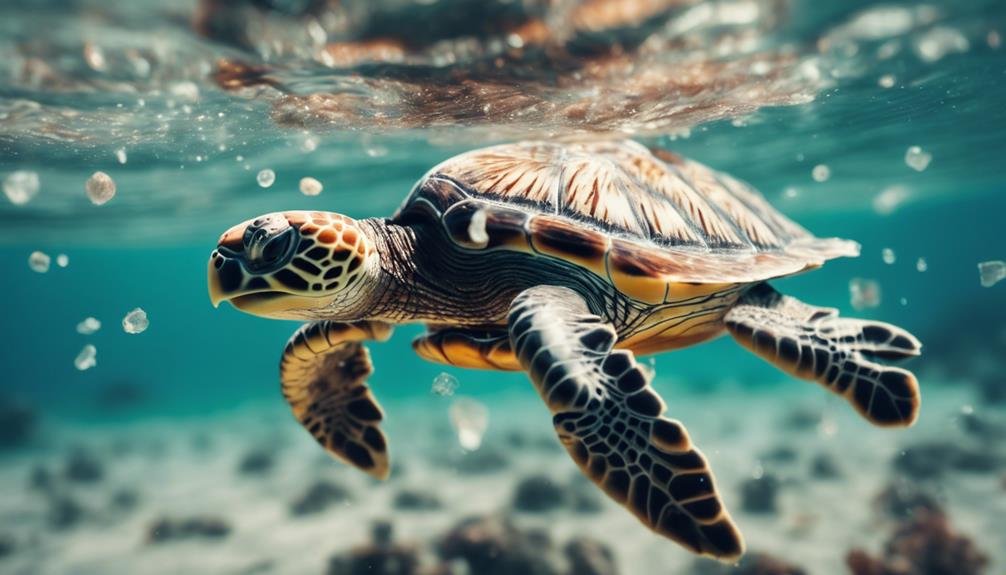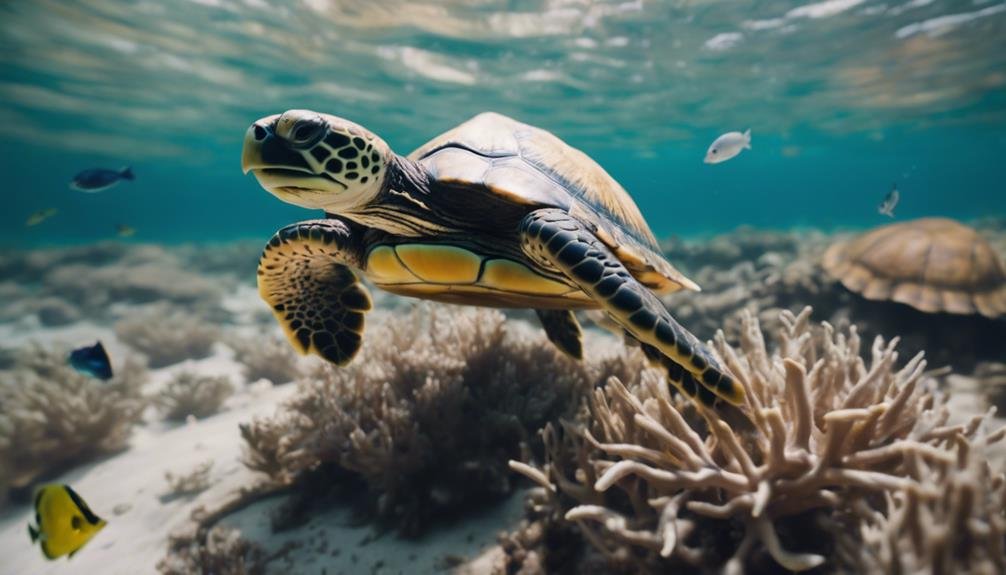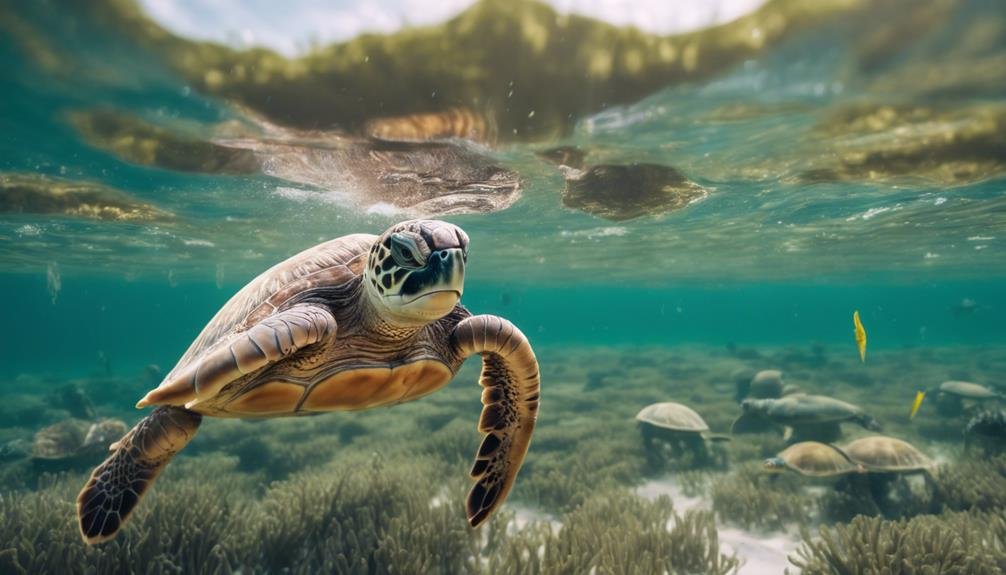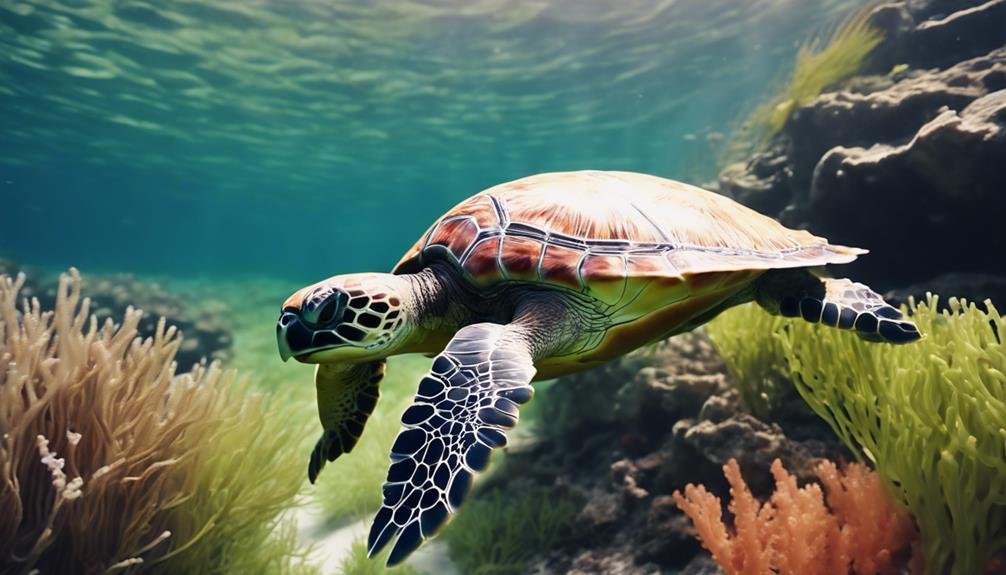You might think you know what turtles eat in the Ocean, but the truth is more fascinating than expected. Sea turtles’ diets vary, ranging from the jellyfish they snatch from the watery depths to the sea grasses that blanket the ocean floor. As they age, their dietary preferences shift dramatically, influenced by their species and the ecosystems they inhabit. This not only affects their survival but also the health of marine environments. Now, you’re probably wondering how this works and why it matters. Let’s explore the intricate dining habits of these ancient mariners and uncover the significance behind their meals.
Key Takeaways
- Sea turtles’ diets include sea grasses, algae, jellyfish, sponges, crabs, and mollusks.
- Leatherback turtles primarily feed on jellyfish, rich in proteins and fats.
- Hawksbill turtles specialize in eating sponges extracted from coral reefs.
- Young sea turtles are carnivorous, focusing on small invertebrates for growth.
- Green turtles mainly rely on sea grasses and algae for nutrients.
Turtles’ Diverse Diet
Sea turtles boast a diverse diet, with various species munching on everything from sea grasses and algae to jellyfish, sponges, and hard-shelled creatures like crabs and mollusks. Depending on the species and their lifecycle stage, what turtles eat can greatly vary. For instance, young turtles, including green turtles, start their lives being more carnivorous, feasting on small invertebrates in their oceanic nurseries. This high-protein diet is essential for their rapid growth during the early years.
As juvenile turtles mature, their diet begins to diversify even more. Loggerhead juveniles, for example, might hone their foraging skills on various hard-shelled prey, learning to navigate the challenges of cracking open shells to access the nutritious meat inside. Meanwhile, juvenile hawksbill turtles specialize in spongiform, seeking out specific types of sponges that contribute to their unique dietary needs.
Understanding what turtles eat at different stages of life is important for their survival and for maintaining the delicate balance of marine ecosystems. Conservation efforts often focus on protecting the diverse habitats supporting sea turtles’ varied diets, ensuring these ancient mariners thrive in the Ocean.
Sea Grass and Algae Consumption
While many sea turtles enjoy a varied diet, green turtles, in particular, depend largely on sea grasses and algae for their nutrition. These marine plants are more than just a meal; they’re a cornerstone of green turtles’ health, providing the essential nutrients and fiber these creatures need to thrive. It’s not just green turtles that benefit from this plant-based diet; sea grass and algae play a significant role for various species, supporting their digestion and overall well-being.
Seagrass and algae are abundant and a powerhouse of nutrition. These plants are essential in maintaining the health and survival of sea turtles in their ocean habitats. As turtles graze on these underwater fields, they feed themselves and play a part in the ecosystem, helping keep the seagrass beds healthy and productive.
Jellyfish: A Favorite Meal


You might be surprised to learn that jellyfish are more than just a floating snack for sea turtles; they’re packed with nutritional value essential for their long migrations.
With their specialized jaws, Leatherback turtles are pros at hunting these gelatinous creatures. Unfortunately, the similarity between jellyfish and plastic bags can lead to dangerous mistakes, threatening turtle health.
Jellyfish Nutritional Value
Many sea turtles favor jellyfish among various dietary choices because of their significant nutritional value. Jellyfish provide them with the essential proteins and fats needed for energy.
Jellyfish are abundant in the Ocean and are a common and important food source, particularly for species like leatherback turtles, which primarily feed on these gelatinous creatures.
The proteins and fats found in jellyfish are key components of a sea turtle’s diet, effectively meeting their energy and nutrient requirements.
This nutritional profile helps sea turtles maintain their health and stamina for swimming long distances.
Given their abundance, jellyfish offer a reliable food option, ensuring sea turtles have access to the essential nutrients they need to thrive in their oceanic habitats.
Hunting Techniques Explained
Understanding the nutritional value of jellyfish and exploring how sea turtles skillfully hunt these slippery prey in the Ocean is fascinating. You’ll be amazed that sea turtles rely on their exceptional vision to spot jellyfish floating around. But it’s not just about seeing them; they also use their keen sense of smell to detect jellyfish nearby.
Once on the trail, some turtles, especially the leatherback species, have an ace up their sleeve. They possess specialized papillae in their mouths, which are small, hook-like structures that help them grip onto the slippery jellyfish without letting them escape.
Sea turtles actively search the Ocean for jellyfish, diving into the depths because these creatures are more than just a meal; they’re a crucial source of energy and nutrients, making them an indispensable part of the turtle’s diet.
Hawksbill Turtles and Sponges
You’ve learned about jellyfish as a popular menu item for some turtles, but now, let’s turn your attention to hawksbill turtles and their unique dining habits.
These turtles strongly prefer sponges, thanks to their sharply pointed beaks allow them to extract their favorite food from hard-to-reach spots in coral reefs. This specific feeding behavior shows their dietary uniqueness and underscores their crucial role in preserving the balance within coral reef ecosystems.
Hawksbill Diet Specifics
Hawksbill turtles primarily feast on sponges, an essential component of their diet that enables them to play an important role in the health and diversity of coral reef ecosystems. Their narrow, pointed beak is a specialized tool, allowing them to extract sponges tucked away in the crevices and cracks of coral reefs.
This unique feeding habit provides them with the necessary nutrients and energy and helps maintain the ecosystem’s balance. By focusing on sponges, hawksbill turtles contribute to shaping marine biodiversity. Their diet directly impacts the health of coral reefs, underscoring their vital role in the Ocean’s ecological dynamics.
You’ll find these turtles are key players in preserving the intricate balance of marine life.
Sponges: Preferred Food
Expanding on the significance of their diet, it’s remarkable that Hawksbill turtles have a specific preference for sponges in the Ocean. These creatures aren’t just any marine diner; they’re crucial in the grand scheme of ocean health. Their meal choice does more than satisfy hunger; it plays a critical role in the ecosystem.
- Specialized Feeding Behavior: Their unique diet helps maintain a balanced coral reef ecosystem.
- Beak Design: The shape of their beak is perfectly adapted to forage on tough sponges.
- Ecosystem Impact: By controlling sponge populations, they safeguard the diversity and health of reef habitats.
- Influence on Reef Organisms: Their feeding habits support the abundance of other marine life, fostering a rich biodiversity.
Hawksbill turtles’ penchant for sponges underscores their crucial role in oceanic health and balance.
The Plastic Pollution Threat


As a direct consequence of plastic pollution, approximately 52% of sea turtles worldwide have ingested plastic, greatly endangering their lives. This startling statistic highlights a grim reality in our oceans. Every piece of plastic a turtle encounters increases its risk of death. Mistaking a plastic bag for a jellyfish can prove fatal for these creatures. It’s not just about the immediate threat; the ingestion of plastic affects their digestive system, compromising their health and survival.
Here’s a closer look at the numbers:
| Quantity of Plastic Ingested | Chance of Mortality | Impact |
|---|---|---|
| One piece | 22% | High |
| Up to 200 pieces | Likely death | Severe |
| – | – | – |
| – | – | – |
Seeing these figures, it’s clear that the problem isn’t just environmental but deeply personal for each turtle. With over half of the sea turtle population already affected, the time to act is now. Reducing plastic use and improving waste management can help turn the tide against this threat. It’s not just about saving turtles; it’s about preserving the health of our oceans and the myriad of life within them.
Impact of Diet on Habitat
Beyond immediate threats like plastic pollution, sea turtles’ diets play a pivotal role in the health of marine ecosystems. You mightn’t realize it, but what these ancient mariners choose to munch on directly impacts their surroundings significantly. By fulfilling their roles in the Ocean’s food web, they help maintain the delicate balance necessary for thriving marine life.
- Green turtles graze on sea grasses, essential for controlling these plants’ growth and ensuring the seabed’s health and stability. Without their feeding habits, seagrass beds could overgrow, disrupting the habitat for many marine species.
- Loggerhead turtles focus on hard-shelled organisms like conchs and sea urchins. Their diet helps keep the population of these creatures in check, preventing them from becoming too dominant and altering the marine landscape.
- Sea turtles’ varied diets influence biodiversity, ensuring that many species coexist and thrive in the Ocean.
- By maintaining the balance of their habitats, sea turtles indirectly support the overall health of the oceans, impacting everything from coral reefs to the fish populations humans rely on for food.
Understanding how sea turtles’ dietary habits influence their environment highlights the interconnectedness of life under the sea and the importance of protecting these magnificent creatures.
Protecting Turtle Feeding Grounds


Numerous turtle feeding grounds, essential for survival, face threats from human activities such as pollution and habitat destruction. These areas are pivotal as they provide sea turtles with the primary food sources to survive and thrive. By protecting these feeding grounds, you’re helping guarantee that sea turtles have access to the necessary nutrients that support their health and longevity.
Human actions, including pollution and destroying natural habitats, can severely disrupt and harm these essential areas. These activities jeopardize the turtles’ ability to find food and threaten survival. It’s imperative to understand that safeguarding turtle feeding grounds isn’t just about preserving a single species; it’s about maintaining the health of marine ecosystems.
Conservation efforts are key to preserving and restoring these critical habitats. By focusing on protecting turtle feeding grounds, you contribute to supporting healthy sea turtle populations. This involves preventing further damage and actively participating in restoration efforts where damage has occurred. In doing so, you play a crucial role in ensuring the survival of sea turtles for generations to come.
Initiatives Against Plastic Debris
Efforts to combat plastic debris have led to impactful initiatives, including beach clean-up programs and bans on single-use plastics. As you’ve noticed, with the increasing ocean pollution, it’s important to understand how various organizations and countries are stepping up to address this issue. There’s a united effort to turn the tide against oceanic plastic pollution from the grassroots to global policies.
- Beach clean-up programs organized by conservation groups aren’t just about removing shoreline trash. They’re a call to action, inspiring communities to take responsibility for their local environment and wildlife.
- Bans on single-use plastics in several countries represent a significant policy shift towards sustainable consumption. These bans directly respond to the plastic crisis, aiming to reduce waste entering our oceans.
- Innovative technologies, like floating barriers, are being developed to capture ocean plastic. This approach showcases human ingenuity in solving complex environmental problems.
- Educational campaigns focus on reducing plastic use and proper disposal. They empower individuals with knowledge, turning everyday choices into acts of conservation.
These initiatives are more than actions; they demonstrate what can be achieved by working together to create a cleaner, healthier ocean.
Ensuring Sea Turtles’ Future


To protect sea turtles‘ future, conservationists focus on safeguarding nesting grounds and educating the public about their critical role in marine ecosystems. You’ve got a part to play, too. Understanding these creatures’ threats makes you more equipped to help make a difference. Monitoring and reducing plastic pollution isn’t just an important deed; it’s essential for the survival of sea turtles. Every piece of plastic you refuse, reduce, or recycle can create a safer ocean for them.
Climate change is another big hurdle, affecting nesting sites and altering migration routes. It’s making the survival of sea turtles even more precarious. By supporting policies that address climate change, you’re helping guarantee these ancient mariners can continue their age-old journey.
Conservation programs aiming to increase hatchling survival rates are crucial. These efforts give sea turtles a fighting chance from the moment they emerge from their nests. Your support for these initiatives, whether through donations or volunteer work, can significantly impact their success.
Can Turtles in the Ocean Eat Grapes?
Turtles eating grapes is a surprising fact. While turtles in the Ocean primarily feed on seaweed, jellyfish, and small crustaceans, they have been known to consume grapes if floating in the water. However, it’s important to note that offering grapes to turtles can harm their health.
Conclusion
You’ve learned that sea turtles eat a diverse diet, which includes sea grass and algae, jellyfish, and sponges.
However, plastic pollution significantly threatens their feeding habits and habitats.
Safeguarding their feeding grounds and addressing plastic debris are crucial steps towards ensuring their future.
By grasping and supporting efforts against ocean pollution, you can help preserve the balance of marine ecosystems and safeguard the survival of these fascinating creatures in our oceans.
FAQs
1. What Do Turtles Eat in the Ocean?
You might be wondering what turtles munch on under the sea. Well, they’ve got a diverse menu! Depending on the species, they feast on sea grasses, algae, jellyfish, and sponges. Hawksbill turtles love sponges, while green turtles go for seagrasses. Some even snack on jellyfish.
Omnivores enjoy both plant and animal treats. Their diet is essential for their survival and keeps the ocean ecosystem healthy.
2. What Are 5 Facts About Sea Turtles?
You’re curious about sea turtles, aren’t you? Here are five fascinating facts:
Their diet can include jellyfish, seaweed, and sometimes plastic, leading to fatal consequences.
Next, they’ve been around for over 100 million years!
Third, females return to their birthplace to lay eggs.
Additionally, they can hold their breath for hours.
Lastly, climate change affects their sex ratio, with warmer sands producing more females.
Isn’t nature incredible?
3. What Do Turtles Eat Fun Facts?
You’re diving into the world of sea turtles, curious about their dining habits? Here’s a feast of fun facts:
- Green sea turtles munch on sea grasses and algae, helping keep the Ocean’s garden tidy.
- Loggerhead turtles crack open crabs and snails with their strong jaws.
- Leatherback turtles slurp up jellyfish, keeping those stingers in check.
- Hawksbill turtles snack on sponges, safeguarding coral reefs.
- Each turtle plays an essential role in their marine ecosystem!
4. How Do Turtles Survive in the Ocean?
You’re likely curious about how turtles survive in the vast Ocean.
Well, it’s all about their diet. They munch on various foods, including sea grasses, algae, jellyfish, and sponges.
Depending on the species, some turtles have specialized diets to keep them healthy and full of energy.
Their unique feeding habits help them thrive and play an essential role in maintaining the Ocean’s ecological balance.
Related Article
https://thereptileguide.com/corn-snake-lifespan/
https://thereptileguide.com/corn-snake-pet/
https://thereptileguide.com/red-morph-bearded-dragon/


